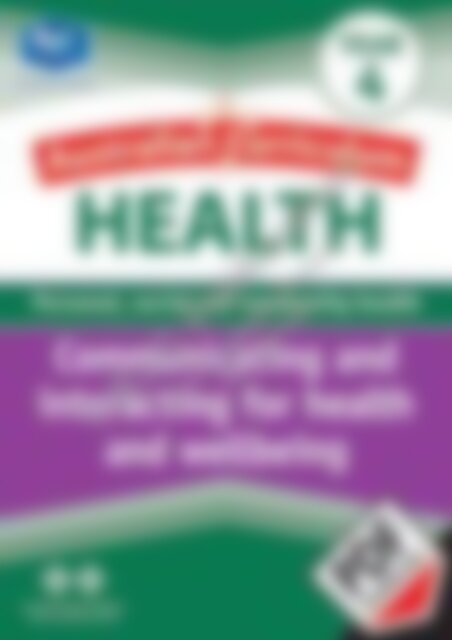RIC-20013 AC Health (Year 4) Communicating for health and wellbeing
Create successful ePaper yourself
Turn your PDF publications into a flip-book with our unique Google optimized e-Paper software.
©R.I.C. Publications<br />
Low Resolution Images<br />
Display Copy
Australian Curriculum <strong>Health</strong> (<strong>Year</strong> 4)<br />
Published by R.I.C. Publications ® 2016<br />
Copyright @ R.I.C. Publications ® 2016<br />
<strong>RIC</strong>- <strong>20013</strong><br />
Copyright Notice<br />
A number of pages in this book are worksheets.<br />
The publisher licenses the individual teacher<br />
who purchased this book to photocopy these<br />
pages to h<strong>and</strong> out to students in their own<br />
classes.<br />
Titles in this series:<br />
Australian Curriculum <strong>Health</strong> (Foundation)<br />
Australian Curriculum <strong>Health</strong> (<strong>Year</strong> 1)<br />
Australian Curriculum <strong>Health</strong> (<strong>Year</strong> 2)<br />
Australian Curriculum <strong>Health</strong> (<strong>Year</strong> 3)<br />
Australian Curriculum <strong>Health</strong> (<strong>Year</strong> 4)<br />
Australian Curriculum <strong>Health</strong> (<strong>Year</strong> 5)<br />
Australian Curriculum <strong>Health</strong> (<strong>Year</strong> 6)<br />
All material identified by O is material subject to copyright<br />
under the Copyright Act 1968 (Cth) <strong>and</strong> is owned by the Australian<br />
Curriculum, Assessment <strong>and</strong> Reporting Authority 2016.<br />
For all Australian Curriculum material except elaborations: This is<br />
an extract from the Australian Curriculum.<br />
Elaborations: This may be a modified extract from the Australian<br />
Curriculum <strong>and</strong> may include the work of other authors.<br />
Disclaimer: <strong>AC</strong>ARA neither endorses nor verifies the accuracy of the<br />
in<strong>for</strong>mation provided <strong>and</strong> accepts no responsibility <strong>for</strong> incomplete or<br />
inaccurate in<strong>for</strong>mation.<br />
In particular, <strong>AC</strong>ARA does not endorse or verify that:<br />
• The content descriptions are solely <strong>for</strong> a particular year <strong>and</strong><br />
subject;<br />
• All the content descriptions <strong>for</strong> that year <strong>and</strong> subject have been<br />
used;<strong>and</strong><br />
• The author's material aligns with the Australian Curriculum content<br />
descriptions <strong>for</strong> the relevant year <strong>and</strong> subject.<br />
You can find the unaltered <strong>and</strong> most up to date version of this<br />
material at http://www.australiancurriculum.edu.au/<br />
This material is reproduced with the permission of <strong>AC</strong>ARA.<br />
Cft<br />
I Australian<br />
gw CUR<strong>RIC</strong>ULUM<br />
Except as allowed under the Copyright Act 1968,<br />
any other use (including digital <strong>and</strong> on line uses<br />
<strong>and</strong> the creation of overhead transparencies<br />
or posters) or any use by or <strong>for</strong> other people<br />
(including by or <strong>for</strong> other teachers, students or<br />
institutions) is prohibited. If you want a licence<br />
to do anything outside the scope of the BLM<br />
licence above, please contact the Publisher.<br />
This in<strong>for</strong>mation is provided to clarify the limits<br />
of this licence <strong>and</strong> its interaction with the<br />
Copyright Act.<br />
For your added protection in the case of<br />
copyright inspection, please complete the <strong>for</strong>m<br />
below. Retain this <strong>for</strong>m, the complete original<br />
document <strong>and</strong> the invoice or receipt as proof<br />
of purchase.<br />
Name of Purchaser:<br />
Date of Purchase:<br />
Supplier:<br />
School Order# (if applicable):<br />
Signature of Purchaser:<br />
©R.I.C. Publications<br />
Low Resolution Images<br />
Display Copy<br />
Internet websites<br />
In some cases, websites or specific UR Ls may be recommended. While these are checked <strong>and</strong> rechecked at the time of publication,<br />
the publisher has no control over any subsequent changes which may be made to webpages. It is strongly recommended that the<br />
class teacher checks all URLs be<strong>for</strong>e allowing students to access them.<br />
View all pages online<br />
PO Box 332 Greenwood Western Australia 6924<br />
Website: www.ricpublications.com.au<br />
Email: mail@ricpublications.com.au<br />
R.I.C. PUBLICATIONS<br />
YOUR PARTNER IN EDUCATION<br />
AUSTRALIAN<br />
PRIMARY PUBLISHER<br />
OF THE YEAR<br />
2015 & 2016
Australian Curriculum <strong>Health</strong> is a seven-book<br />
series designed to support the teaching <strong>and</strong> learning<br />
of the Personal, social <strong>and</strong> community <strong>health</strong> str<strong>and</strong> of<br />
Australian Curriculum <strong>Health</strong> <strong>and</strong> Physical Education.<br />
Written in lesson-plan <strong>for</strong>mat, the series provides<br />
a variety of teacher resources to assist in the<br />
implementation of <strong>health</strong> lessons.<br />
CONTENTS<br />
Teachers notes ...................................................................................................................................... iv-v<br />
Being <strong>health</strong>y, safe <strong>and</strong> active ......................................................................................................... 2-41<br />
We all need support .......................................................................................................................... 2-5<br />
Let's keep trying ................................................................................................................................ 6-9<br />
Changes in me .. .. .......................................................................................................................... I 0-13<br />
A little help from my friends .. ......................................................................................................... I 4-17<br />
Fight or flight .................................................................................................................................. 18-21<br />
Saying NO ..................................................................................................................................... 22-25<br />
Poison! Beware! ............................................................................................................................ 26-29<br />
<strong>Health</strong>y eating ............................................................................................................................... 30-33<br />
Finding a balance .......................................................................................................................... 34-37<br />
Play safe ........................................................................................................................................ 38-41<br />
©R.I.C. Publications<br />
Low Resolution Images<br />
Display Copy<br />
<strong>Communicating</strong> <strong>and</strong> interacting <strong>for</strong> <strong>health</strong> <strong>and</strong> <strong>wellbeing</strong> .......................................................... 42-61<br />
Mind over body .............................................................................................................................. 42-45<br />
Diversity, the spice of life ............................................................................................................... 46-49<br />
Different shades of bullying ........................................................................................................... 50-53<br />
Emotions ....................................................................................................................................... 54-57<br />
<strong>Health</strong> messages ........................................................................................................................... 58-61<br />
Contributing to <strong>health</strong>y <strong>and</strong> active communities .......................................................................... 62-81<br />
An active life .................................................................................................................................. 62-65<br />
A <strong>health</strong>y life .................................................................................................................................. 66-69<br />
The great outdoors ........................................................................................................................ 70-73<br />
Celebrating cultural diversity .......................................................................................................... 74-77<br />
Respecting differences ................................................................................................................... 78-81<br />
R.I.C. Publications ® www.ricpublications.com.au Australian Curriculum <strong>Health</strong> (<strong>Year</strong> 4) Ill
:,<br />
. FORMAT OF "FHE BOOK .....<br />
This comprehensive teacher resource is divided into 20 units which cover the three <strong>health</strong> sub-str<strong>and</strong>s-Being<br />
<strong>health</strong>y, safe <strong>and</strong> active; <strong>Communicating</strong> <strong>and</strong> interacting <strong>for</strong> <strong>health</strong> <strong>and</strong> <strong>wellbeing</strong>; <strong>and</strong> Contributing to <strong>health</strong>y <strong>and</strong><br />
active communities.<br />
Each sub-str<strong>and</strong> section contains a varied number of units.<br />
Each unit contains a teachers page <strong>and</strong> three supporting pages.<br />
TE<strong>AC</strong>HERS PAGE<br />
+ The title of the unit is provided ..• , Let's keep 11y1ng<br />
;··· ............................................• IIMI.,_.__.,....,,.<br />
+ h ;.; vant sub-str<strong>and</strong>.... .......... .. ! /" ;i:_f [ =--l<br />
.. --·-,--<br />
+ Details of the lesson are '.·-:::;·_,._.,...h_<br />
shown in the Introduction,<br />
dl'Dilul'earo:IOCMnily.Oiooolll-oncl<br />
_______ .,_______ ----• ::-,.:,:=..c::.:<br />
Development <strong>and</strong> Conclusion<br />
· =,:::<br />
+ Differentiation gives<br />
suggestions <strong>for</strong> catering <strong>for</strong><br />
different ability levels, <strong>and</strong><br />
sugg e s t ions <strong>for</strong> varyin g the ·------------------·<br />
lesson<br />
• &Jshlrnolcer1(1ndlr>gred-lOOiogoMI<br />
------·• The content description<br />
j supported by the unit is<br />
given<br />
· :E:"::::::=- =. :: . :;:;:...:···--.,·· ···················• Suggested resources<br />
•Skid.,1'1""""1""'P"ll"8.<br />
•R oo:lhoulJlllho""""pioyan-.<br />
·--OOl
·s;<br />
:;::::<br />
CJ<br />
C C, >-<br />
C<br />
C<br />
=<br />
·a;<br />
Ill<br />
CJ<br />
"6<br />
C) 'iii ::9 ::,<br />
::, >- ><<br />
.. .c G) Cl)<br />
'C Q. ;: Ill<br />
.. C .... 'C 'C<br />
Cl) 0 0 C C<br />
.c- :;:::: C C<br />
'i: Ill<br />
0 - -<br />
Ill<br />
;;::::: .c<br />
'C ::, .:!:: Q.<br />
C<br />
Cl)<br />
C C C .c<br />
C 'C Cl) Cl) Ill<br />
C .c_ .c C<br />
0 C 0<br />
.c .c ct "6 :;:::: <br />
8c 'C - = -- c-<br />
Oz cm C :C - V, .!<br />
Cl) Cl) :iE cc c-<br />
Pages Ou., Cl)<br />
<br />
E 'C<br />
C<br />
'C<br />
C 'C<br />
C C<br />
>-<br />
C<br />
C Cl)<br />
C,<br />
i5.. C<br />
--<br />
Cl)<br />
=-<br />
- C. C<br />
CJ ct<br />
ct<br />
.c<br />
ct- o- 0<br />
C<br />
Cl)<br />
E<br />
Cl)<br />
><br />
0<br />
:Si:<br />
Ill E<br />
Ill Cl)<br />
-<br />
Cl)<br />
:;::::<br />
C<br />
><br />
Cl) ·s; 'iii<br />
-<br />
:;:::: Ill<br />
E CJ<br />
Cl)<br />
Cl)<br />
C<br />
> Ill Q.<br />
0 .. "6 ><<br />
E 0 CJ Cl)<br />
Q.<br />
Ill 'iii 'C<br />
C >- C<br />
- 'C<br />
C<br />
.c C<br />
C<br />
Cl)<br />
Q.<br />
C -<br />
E<br />
C)<br />
Ill c- E<br />
c- Cl) oct .c<br />
C:iE<br />
CV, .! -I<br />
>-w<br />
::, lL<br />
.c<br />
u..- CJ ·-<br />
...J--I<br />
cc-<br />
'C "'<br />
e- - --<br />
©R.I.C. Publications<br />
Low Resolution Images<br />
Display Copy<br />
R.I.C. Publications ® www.ricpublications.com.au<br />
Australian Curriculum <strong>Health</strong> (<strong>Year</strong> 4)<br />
v
,, .. M hid· Over body ·· ·-···· ···- · ·· .. ,<br />
<strong>Communicating</strong> <strong>and</strong> interacting <strong>for</strong> <strong>health</strong> <strong>and</strong> <strong>wellbeing</strong><br />
The lesson<br />
Introduction<br />
• Show pictures of famous people <strong>and</strong> ask who<br />
likes or dislikes them, giving reasons why.<br />
• Categorise reasons <strong>for</strong> liking/disliking a<br />
celebrity under the following headings:<br />
- 'How the person interacts with others'<br />
- 'How the person per<strong>for</strong>ms in his/her career'<br />
- 'What the person looks like'<br />
Discuss the difference.<br />
Development<br />
• What does your body allow you to do? What<br />
does your appearance allow you to do? Do<br />
either of them (body or appearance) make you<br />
who you are?<br />
• When can you say you know or like a person?<br />
Is it as soon as you meet them (<strong>and</strong> see what<br />
they look like) or is it after you've spent time in<br />
their company to find out how they interact with<br />
others <strong>and</strong> the environment?<br />
• Students complete the activities on page 43.<br />
• Discuss how illogical it is to like someone<br />
because of how they look.<br />
• Complete the activity on page 44. How would<br />
you like being told who you could <strong>and</strong> could<br />
not be friends with based on how they looked?<br />
What would be your objections?<br />
Differentiation<br />
The activities are all outcome based. When<br />
completing them, students could be grouped<br />
in mixed abilities <strong>and</strong> the activities discussed<br />
be<strong>for</strong>e being completed.<br />
Conclusion<br />
• Students share their ideas about disregarding<br />
appearances <strong>and</strong> valuing people <strong>for</strong> who they<br />
are; not what they look like.<br />
Content description<br />
Describe how respect, empathy <strong>and</strong><br />
valuing diversity can positively innuence<br />
relationships (<strong>AC</strong>PPS037) 0<br />
Resources<br />
• Sufficient copies of pages 43 <strong>and</strong> 44<br />
• Internet images of famous people<br />
Assessment<br />
• Does the student know how people look is down to<br />
luck (genetics)?<br />
• Does the student know how we interact with others<br />
<strong>and</strong> the environment is a mixture of luck (genetics)<br />
<strong>and</strong> environmental factors?<br />
• Does the student know how we treat others<br />
can affect how they interact with others <strong>and</strong> the<br />
environment?<br />
Going further<br />
• With a partner, read <strong>and</strong> discuss Jordan's story on<br />
page 45. What does it tell you about being different<br />
<strong>and</strong> what different people have to offer?<br />
• Create a booklet of people you know. Describe what<br />
they are like as people. Do not mention what they<br />
look like or what their bodies can do.<br />
• On separate pieces of paper, write reasons why<br />
people may be excluded based on how they look.<br />
Sit the class in one circle all facing inwards with a<br />
waste paper bin in the middle. Students take turns<br />
to read one reason <strong>for</strong> exclusion then they crumple<br />
the paper <strong>and</strong> throw it in the bin.<br />
©R.I.C. Publications<br />
Low Resolution Images<br />
Display Copy<br />
42 Australian Curriculum <strong>Health</strong> (<strong>Year</strong> 4) R.I.C. Publications ® www.ricpublications.com.au
,, . . Mind··over bOdy ::.:·1 ..... .<br />
<strong>Communicating</strong> <strong>and</strong> interacting <strong>for</strong> <strong>health</strong> <strong>and</strong> <strong>wellbeing</strong><br />
Humans are made up of two main parts: the body <strong>and</strong> the<br />
mind. The body is like a machine, helping us to function in our<br />
world, but the mind allows us to respond to our environment.<br />
It is the mind that makes each of us an individual.<br />
Write some things your body <strong>and</strong> your mind can do.<br />
Body<br />
Mind<br />
List some people you enjoy spending time with <strong>and</strong> why you like them.<br />
People I like to<br />
be with<br />
Why I like being with them<br />
©R.I.C. Publications<br />
Low Resolution Images<br />
Display Copy<br />
Tick one box.<br />
I like these people because of their: body D mind D.<br />
Explain whether you think the mind or the body is more important <strong>and</strong> why.<br />
R.I.C. Publications ® www.ricpublications.com.au Australian Curriculum <strong>Health</strong> (<strong>Year</strong> 4) 43
<strong>Communicating</strong> <strong>and</strong> interacting <strong>for</strong> <strong>health</strong> <strong>and</strong> <strong>wellbeing</strong><br />
People are often excluded because their bodies are different in some way. We<br />
should not <strong>for</strong>get; it is the mind that makes the person, not the body.<br />
List all the students in the class, including yourself, by eye colour.<br />
Brown Blue Green<br />
Hazel<br />
Explain how each of the following examples would affect<br />
you <strong>and</strong> your friends.<br />
Example A: You can only be friends with people who<br />
have the same eye colour as you.<br />
Example B:<br />
Exclude as your friends all the people in one eye-colour group.<br />
©R.I.C. Publications<br />
Low Resolution Images<br />
Display Copy<br />
Example C: Exclude as your friends all but one person from each eye-colour group.<br />
What do you think of excluding people based on something physical like eye colour?<br />
44 Australian Curriculum <strong>Health</strong> (<strong>Year</strong> 4) R.I.C. Publications ® www.ricpublications.com.au
,, . . Mind··over bo·ay ::::·3 ..... .<br />
<strong>Communicating</strong> <strong>and</strong> interacting <strong>for</strong> <strong>health</strong> <strong>and</strong> <strong>wellbeing</strong><br />
Your body is something you were born with. You can't take it back <strong>and</strong> ask <strong>for</strong> a<br />
different one. The best you can do is look after it so it will work as well as it can <strong>for</strong><br />
you.<br />
Read the following story <strong>and</strong> consider the situation from Jordan's point of view <strong>and</strong> that<br />
of his classmates.<br />
Jordan sat on the bench <strong>and</strong> watched as his classmates played in the schoolyard.<br />
He would have loved to join in with the football game but no-one wanted him on their<br />
team because he wasn't any good. His arms <strong>and</strong> legs seemed too long <strong>for</strong> his body<br />
<strong>and</strong> he was always tripping over his feet <strong>and</strong> dropping the ball.<br />
He had the same problem in class; no-one wanted<br />
to sit by him. They called him 'daddy long legs' <strong>and</strong><br />
'octopus', <strong>and</strong> complained when his arms <strong>and</strong> legs<br />
spread into their space.<br />
Why did people only ever see what was 'wrong' with him?<br />
Why didn't they ever take the time to find out all the good<br />
stuff about him?<br />
They would discover his love <strong>for</strong> <strong>and</strong> knowledge of the<br />
natural environment; there was nothing about the l<strong>and</strong>,<br />
oceans or space that Jordan didn't have an interest in.<br />
He was really good at sketching, too. The walls of his<br />
home were covered with pictures he had drawn of<br />
family <strong>and</strong> friends, plants <strong>and</strong> animals; but none of his<br />
classmates would ever see them. No-one wanted to go<br />
to Jordan's house <strong>for</strong> a play date.<br />
Jordan was a very lonely boy.<br />
©R.I.C. Publications<br />
Low Resolution Images<br />
Display Copy<br />
What could Jordan <strong>and</strong> his classmates do to make his life happier?<br />
Jordan<br />
Classmates<br />
R.I.C. Publications ® www.ricpublications.com.au<br />
Australian Curriculum <strong>Health</strong> (<strong>Year</strong> 4) 45
,,. Diversity; the spice of life<br />
<strong>Communicating</strong> <strong>and</strong> interacting <strong>for</strong> <strong>health</strong> <strong>and</strong> <strong>wellbeing</strong><br />
The lesson<br />
Introduction<br />
• Show internet images of many species of<br />
different plants <strong>and</strong> animals from different<br />
biomes. Discuss the meaning of diversity <strong>and</strong><br />
how the differences among things enhance the<br />
beauty of life.<br />
• Is any one species 'better' than another?<br />
Discuss the roles of different species in the<br />
food webs of different ecosystems.<br />
Development<br />
• Not one of us is better than another. We are all<br />
different-but with many similarities! Students<br />
investigate this concept as they work in pairs to<br />
complete the activity on page 47.<br />
• Do the differences you discover create<br />
problems between you or are they celebrated<br />
<strong>for</strong> the diversity <strong>and</strong> interest they bring to the<br />
class?<br />
• Working with the same partners, students<br />
identify <strong>and</strong> explore a difference between them.<br />
Discuss the difference between 'accepting' <strong>and</strong><br />
'challenging' each other's ideas or points of<br />
view.<br />
• Students complete the activity on page 48.<br />
Differentiation<br />
The activities are all outcome based. When<br />
completing them, students could be grouped<br />
in mixed abilities <strong>and</strong> the activities discussed<br />
be<strong>for</strong>e being completed.<br />
Conclusion<br />
• Students share the differences between<br />
themselves <strong>and</strong> their partner.<br />
Content description<br />
Describe how respect, empathy <strong>and</strong><br />
valuing diversity can positively influence<br />
relationships (<strong>AC</strong>PPS037) 0<br />
Resources<br />
• Sufficient copies of pages 47 <strong>and</strong> 48<br />
• Internet images of different plant <strong>and</strong> animal<br />
species<br />
Assessment<br />
• Does the student know there is not a single person<br />
on the planet who is absolutely identical to another?<br />
• Does the student know we have many differences<br />
among us, including opinions about <strong>and</strong><br />
preferences <strong>for</strong> a wide range of things?<br />
• Does the student know in our society, celebrating<br />
<strong>and</strong> accepting differences creates harmony?<br />
Going further<br />
• If people are excluded because there is something<br />
different about them, why is anyone ever accepted?<br />
Who decides which differences are acceptable<br />
<strong>and</strong> which are not? What do you think? Complete<br />
the activity on page 49 to identify what is different<br />
about you. Include physical, emotional, intellectual<br />
differences.<br />
• Using instructions from a website, make <strong>and</strong> use a<br />
Newton's disc to illustrate how different things can<br />
be a part of a whole (colours of the rainbow= white).<br />
• Identify important differences among students;<br />
e.g. religion <strong>and</strong> cultural traditions, preferred afterschool<br />
clubs. Choose ways to illustrate how these<br />
differences come together to create one class.<br />
©R.I.C. Publications<br />
Low Resolution Images<br />
Display Copy<br />
46 Australian Curriculum <strong>Health</strong> (<strong>Year</strong> 4) R.I.C. Publications ® www.ricpublications.com.au
,, Diversity, the spice of life .:.. i<br />
<strong>Communicating</strong> <strong>and</strong> interacting <strong>for</strong> <strong>health</strong> <strong>and</strong> <strong>wellbeing</strong><br />
Diversity shows itself in many shapes, sizes <strong>and</strong><br />
colours. Think about the biodiversity of a rain<strong>for</strong>est;<br />
isn't it amazing? Why then do we find it so hard to<br />
accept diversity among humans?<br />
Discover the diversity between you <strong>and</strong> a partner as<br />
you complete the table.<br />
Foods we<br />
eat<br />
Clothes<br />
we wear<br />
Hobbies<br />
we enjoy<br />
Ways we<br />
relax<br />
Books we<br />
read<br />
Similarities<br />
Me<br />
My partner<br />
Me<br />
My partner<br />
Me<br />
My partner<br />
Me<br />
My partner<br />
Me<br />
My partner<br />
Differences<br />
©R.I.C. Publications<br />
Low Resolution Images<br />
Display Copy<br />
Pets we<br />
(want to)<br />
have<br />
Me<br />
My partner<br />
Mark a point on the scale to show the diversity between you <strong>and</strong> your partner.<br />
not very diverse<br />
quite diverse<br />
very diverse<br />
R.I.C. Publications ® www.ricpublications.com.au<br />
Australian Curriculum <strong>Health</strong> (<strong>Year</strong> 4) 47
,,. Diversity; the spice of life - 12· ·· ··· ··· .,.,<br />
<strong>Communicating</strong> <strong>and</strong> interacting <strong>for</strong> <strong>health</strong> <strong>and</strong> <strong>wellbeing</strong><br />
Diversity enriches life, teaching us about a world with so much more to offer than<br />
we realise. Underst<strong>and</strong>ing another's opinions helps us to see our world from a<br />
different perspective.<br />
Choose a difference between you <strong>and</strong> your partner. Write some questions to learn more<br />
about this difference <strong>and</strong> his or her opinion.<br />
Difference:<br />
Questions<br />
Answers<br />
What do you think is the difference between 'accepting' <strong>and</strong> 'challenging' a person's<br />
opinion?<br />
What skills can you learn from accepting the opinions of others while still holding firm<br />
with your own?<br />
©R.I.C. Publications<br />
Low Resolution Images<br />
Display Copy<br />
Do you think it would be better <strong>for</strong> all people to have the same or different opinions about<br />
things? Explain your answer.<br />
48 Australian Curriculum <strong>Health</strong> (<strong>Year</strong> 4) R.I.C. Publications ® www.ricpublications.com.au
,,."Diversity;· the spice of life - ·3 ·· · .,. ·· ·•·•<br />
<strong>Communicating</strong> <strong>and</strong> interacting <strong>for</strong> <strong>health</strong> <strong>and</strong> <strong>wellbeing</strong><br />
One thing that is the same <strong>for</strong> all of us is that we are all different from one another.<br />
Like blades of grass, no two people are exactly alike. Even identical twins have<br />
differences that help people tell them apart.<br />
Take a very close look at yourself to find the differences that make you unique.<br />
Things about me that make me unique<br />
©R.I.C. Publications<br />
Low Resolution Images<br />
Display Copy<br />
R.I.C. Publications ® www.ricpublications.com.au Australian Curriculum <strong>Health</strong> (<strong>Year</strong> 4) 49
,, .. Different" shades Of tiullyinf<br />
<strong>Communicating</strong> <strong>and</strong> interacting <strong>for</strong> <strong>health</strong> <strong>and</strong> <strong>wellbeing</strong><br />
The lesson<br />
Introduction<br />
• What is bullying? Write students' suggestions<br />
on the board until a full description can be<br />
created from their ideas-deliberate <strong>and</strong><br />
repeated behaviour that causes physical or<br />
emotional pain.<br />
Development<br />
• Discuss different types of bullying-physical,<br />
emotional, passive <strong>and</strong> secret. List examples of<br />
each.<br />
• What should a person who is being bullied do?<br />
Discuss the different people students would<br />
trust to talk to about being bullied.<br />
• Students complete the activity on page 51.<br />
• Discuss the different roles within any bullying<br />
scenario: the bully, the person being bullied, the<br />
bully's supporters, the victim's supporters <strong>and</strong><br />
the byst<strong>and</strong>ers. How do you think each person<br />
contributes to the bullying or tries to stop it?<br />
• Students discuss how often they have played<br />
the different roles in a bullying scenario.<br />
• Students complete the activity on page 52.<br />
Differentiation<br />
The activities are all outcome based. When<br />
completing them, students could be grouped<br />
in mixed abilities <strong>and</strong> the activities discussed<br />
be<strong>for</strong>e being completed.<br />
Conclusion<br />
• Students identify the different roles within a<br />
bullying scenario <strong>and</strong> trusted people to whom<br />
they can turn as required.<br />
Content description<br />
Describe how respect, empathy <strong>and</strong><br />
valuing diversity can positively influence<br />
relationships (<strong>AC</strong>PPS037) 0<br />
Resources<br />
• Sufficient copies of pages 51 <strong>and</strong> 52<br />
Answers<br />
Page 51<br />
I. Teacher check<br />
2. Tell someone!<br />
Page 52<br />
I. Teacher check<br />
2. Tell someone!<br />
Assessment<br />
• Does the student know bullies are cowards <strong>and</strong><br />
often insecure?<br />
• Does the student know everyone has a role to play<br />
if bullying is to be stopped?<br />
• Does the student know bullying experiences should<br />
always be reported?<br />
Going further<br />
• Introduce 'secret bullying' <strong>and</strong> explain that this<br />
can be anything from repeatedly getting a person<br />
into trouble by doing bad things oneself <strong>and</strong><br />
then blaming another, to cyberbullying. Students<br />
complete page 53.<br />
• Discuss Grace's character <strong>and</strong> how she changed<br />
the dynamics of the group. Why do you think she<br />
behaved in this way?<br />
• Design anti-bullying posters to display around the<br />
school.<br />
• Dramatise a story about bullying, from the school<br />
library, to per<strong>for</strong>m to younger students.<br />
©R.I.C. Publications<br />
Low Resolution Images<br />
Display Copy<br />
SO Australian Curriculum <strong>Health</strong> (<strong>Year</strong> 4) R.I.C. Publications ® www.ricpublications.com.au
,,."Differenfshades Of bullyinf-··t·<br />
Behaviour is said to be 'bullying' when it is<br />
deliberately <strong>and</strong> repeatedly used to cause<br />
physical or emotional pain to someone. There<br />
are different types of bullying behaviour.<br />
I. Gi ve examples of each type of bullyi ng.<br />
<strong>Communicating</strong> <strong>and</strong> interacting <strong>for</strong> <strong>health</strong> <strong>and</strong> <strong>wellbeing</strong><br />
©R.I.C. Publications<br />
Low Resolution Images<br />
Display Copy<br />
2. Rearrange the let ters to di s cover wh at you shoul d do i f you are ever bullied.<br />
eeel l m noo s t<br />
_______!<br />
R.I.C. Publications ® www.ricpublications.com.au<br />
Australian Curriculum <strong>Health</strong> (<strong>Year</strong> 4) 51
,,."Differenfshades Of bull Yi n Q=-· 2 ··· ··· .,., ···· ·· · ···<br />
<strong>Communicating</strong> <strong>and</strong> interacting <strong>for</strong> <strong>health</strong> <strong>and</strong> <strong>wellbeing</strong><br />
There are many actors in a bullying scenario, including those who allow bullying to<br />
continue. They can also be accused of bullying. What role do you play?<br />
I. For each scenario, tick one box:<br />
A- always B - often C - sometimes<br />
D-never<br />
I openly support the bully<br />
because I think he or she<br />
is cool.<br />
A-Ds-Dc-Do-D<br />
I step in <strong>and</strong> confront the bully <strong>and</strong> help<br />
the person he or she is bullying.<br />
A-Ds-Dc-Do-D<br />
I am the bully.<br />
A-Ds-D<br />
c-Do-D<br />
I watch what's going on from.<br />
a distance.<br />
A-Ds-Dc-Do-D<br />
I see what's happening <strong>and</strong> walk the other way.<br />
A-Ds-Dc-Do-D<br />
I don't do anything myself but I<br />
watch <strong>and</strong> cheer when the bully<br />
steps into action.<br />
A-Ds-Dc-Do-D<br />
I am the person being bullied.<br />
A-Ds-D<br />
c-Do-D<br />
©R.I.C. Publications<br />
Low Resolution Images<br />
Display Copy<br />
I step in <strong>and</strong> confront the bully <strong>and</strong><br />
try to find out why he or she wants to<br />
cause pain to another person.<br />
A-Ds-Dc-Do-D<br />
2. Rearrange the letters to discover what you should do if you see someone being<br />
bullied but you're too afraid to do anything about it.<br />
elosmetnole<br />
52 Australian Curriculum <strong>Health</strong> (<strong>Year</strong> 4)<br />
_______ !<br />
R.I.C. Publications ® www.ricpublications.com.au
,, .. Differenfshades Of l>Ullying _:·3· ·· ·•·•<br />
<strong>Communicating</strong> <strong>and</strong> interacting <strong>for</strong> <strong>health</strong> <strong>and</strong> <strong>wellbeing</strong><br />
Many bullies like the support of their 'gang' but there are those who bully in secret;<br />
cowards who inflict their pain under a cloak of invisibility.<br />
Discuss the events of the following story.<br />
Grace's parents had money problems <strong>and</strong> her older brothers were in trouble at<br />
school again. The family had to move house <strong>and</strong> she <strong>and</strong> her brothers had to<br />
change schools. Life was not good.<br />
The girls at Grace's new school all seemed very friendly <strong>and</strong> she had her choice<br />
of groups to join. But she didn't want to be 'the new girl', just tagging on to another<br />
group. She wanted a group that would be known as 'Grace's group'.<br />
It didn't take Grace long to find a way to disrupt the social harmony of her class.<br />
She quickly discovered who were the 'leaders' <strong>and</strong> 'followers' in each group <strong>and</strong><br />
which would be the easiest to conquer.<br />
Having chosen her target group, Grace set about making them love her. She<br />
brought in treats <strong>for</strong> them, invited them to play dates after school <strong>and</strong> arranged <strong>for</strong><br />
her parents to take them all on outings at weekends. The girls were hooked. Grace<br />
was truly 'one of them'.<br />
She had deliberately chosen a group in which none of the girls was bothered about<br />
being leader. They all enjoyed each other's company <strong>and</strong> had lots of fun together.<br />
But that was about to change.<br />
Knowing all the girls had<br />
social media accounts, Grace<br />
created a fake identity with<br />
her brothers' help. She began<br />
telling lies about her friends<br />
<strong>and</strong> excluding some of them<br />
from group chats. The effect<br />
was devastating.<br />
©R.I.C. Publications<br />
Low Resolution Images<br />
Display Copy<br />
Each day when Grace came<br />
into school, she pretended to<br />
be shocked about the latest<br />
lies that were being spread.<br />
She com<strong>for</strong>ted her friends who<br />
were so upset by these nasty<br />
events <strong>and</strong> they started to look upon her as their leader.<br />
Grace got what she wanted; but she didn't want to stop. She realised how powerful<br />
her secret weapon was <strong>and</strong> she would continue to use it.<br />
R.I.C. Publications ® www.ricpublications.com.au Australian Curriculum <strong>Health</strong> (<strong>Year</strong> 4) 53
,, .. Emotions<br />
<strong>Communicating</strong> <strong>and</strong> interacting <strong>for</strong> <strong>health</strong> <strong>and</strong> <strong>wellbeing</strong><br />
The lesson<br />
Introduction<br />
• What do you think emotions are? Record<br />
students' suggestions on the board. Categorise<br />
them as positive or negative.<br />
• Read some short stories about emotions that<br />
students may know from their earlier years.<br />
(See 'Resources' <strong>for</strong> examples.)<br />
Development<br />
• How do emotions affect the way you think<br />
<strong>and</strong> behave? How does your body (language)<br />
react when you feel different emotions? Share<br />
responses.<br />
• What colours would you associate with different<br />
emotions? Show students internet images of<br />
'colours of emotions'.<br />
• Students complete the activity on page 55.<br />
• Do you think it is bad to feel negative emotions?<br />
In groups, students discuss <strong>and</strong> display<br />
personal responses to negative emotions.<br />
What can you do to control your response to<br />
a negative emotion? e.g. counting to IO in the<br />
hope of preventing an angry outburst.<br />
• Having physically released a negative emotion,<br />
it may still linger in the mind. Discuss ways of<br />
sending it on its way.<br />
• Students complete the activities on page 56.<br />
Differentiation<br />
The activities are all outcome based. When<br />
completing them, students could be grouped<br />
in mixed abilities <strong>and</strong> the activities discussed<br />
be<strong>for</strong>e being completed.<br />
Conclusion<br />
• Students share personal experiences of<br />
responses to different emotions.<br />
<br />
Content description<br />
Investigate how emotional responses vary in<br />
depth <strong>and</strong> strength (<strong>AC</strong>PPS038) G<br />
Resources<br />
• Sufficient copies of pages 55 <strong>and</strong> 56<br />
• Internet images of 'colours of emotions'<br />
• Stories about emotions; e.g. The way I feel by Janan<br />
Cain, My many colored days by Dr Seuss, Lots<br />
of feelings by Shelley Rotner, Glad monster, sad<br />
monster by Ed Emberly<br />
Assessment<br />
• Does the student know it is normal to experience<br />
feelings across the spectrum of emotions?<br />
• Does the student know the more we experience<br />
different emotions, the better we become at<br />
controlling them?<br />
• Does the student know the strength of emotion can<br />
vary with circumstances?<br />
Going further<br />
• Develop strategies to cope with controlling different<br />
emotions; e.g. When I feel upset, I will think of funny<br />
things to stop myself from crying.<br />
• Share warning signs you feel that can predict an<br />
emotional response; e.g. When I'm about to cry, my<br />
bottom lip begins to quiver.<br />
• Discuss degrees of emotional response to different<br />
acts or behaviours. When or why might your<br />
emotional response be greater than expected?<br />
Complete page 57.<br />
©R.I.C. Publications<br />
Low Resolution Images<br />
Display Copy<br />
<br />
54 Australian Curriculum <strong>Health</strong> (<strong>Year</strong> 4) R.I.C. Publications ® www.ricpublications.com.au
,, .. Emotions<br />
<strong>Communicating</strong> <strong>and</strong> interacting <strong>for</strong> <strong>health</strong> <strong>and</strong> <strong>wellbeing</strong><br />
Emotions are the responses we feel to the things that happen in our lives. Emotions<br />
can be positive or negative, <strong>and</strong> body language can easily betray which emotion<br />
we are feeling.<br />
When you feel each emotion, describe:<br />
• what you think<br />
• what you do<br />
• how your body reacts.<br />
Shade each section the colour you think matches the emotion .<br />
.<br />
...<br />
.<br />
.<br />
. ...... ...<br />
. ...<br />
• C<br />
• G)<br />
: LI.<br />
. . . . . .<br />
. .<br />
. . . .<br />
. .<br />
. .<br />
....<br />
·..·. '°<br />
<br />
.• • Anger • • .<br />
. . .<br />
.<br />
. .<br />
.. . .<br />
.<br />
. .<br />
.<br />
.<br />
. . . .<br />
... ·.o<br />
. .<br />
. . . . . . . . . . . . . . . . . . . . . . . . . . . . . . . . . . . . .<br />
. .<br />
.. ..<br />
..<br />
....<br />
..<br />
.<br />
.<br />
.<br />
.....<br />
.<br />
..<br />
. ...<br />
.<br />
....<br />
....<br />
. .<br />
.<br />
...<br />
. .<br />
.<br />
·-.. <br />
.. . . .. .. . .<br />
. .<br />
.<br />
..<br />
.<br />
.<br />
.<br />
.<br />
. ..<br />
.<br />
..<br />
......<br />
...<br />
..<br />
..<br />
....<br />
. . . .<br />
..<br />
..<br />
.. . .. ..<br />
.. . ..<br />
. ..<br />
. .<br />
. . . . .<br />
Vi>"· •<br />
<br />
· .. . . . . . . . .<br />
. . . .<br />
©R.I.C. Publications<br />
Low Resolution Images<br />
Display Copy<br />
.. ..<br />
. b .<br />
.·<br />
R .·<br />
..<br />
.<br />
0 .·<br />
. .<br />
. ...<br />
. .<br />
.,, .<br />
""I<br />
C: .•<br />
(/)-""I<br />
•<br />
c ·<br />
-· .<br />
O ::::s •<br />
..<br />
..<br />
.<br />
.<br />
. ..<br />
.<br />
.<br />
R.I.C. Publications ® www.ricpublications.com.au Australian Curriculum <strong>Health</strong> (<strong>Year</strong> 4) 55
,,. Eit1otions·.:: ·2<br />
<strong>Communicating</strong> <strong>and</strong> interacting <strong>for</strong> <strong>health</strong> <strong>and</strong> <strong>wellbeing</strong><br />
When we experience negative emotions, we need to find a way to let them go so we<br />
can start to feel better again. Sometimes our first responses may be too strong <strong>and</strong><br />
we need to control them.<br />
For each negative emotion, write what your first response might be then suggest a<br />
better, more controlled way of letting this emotion go.<br />
Emotion<br />
anger<br />
frustration<br />
jealousy<br />
fear<br />
First response<br />
1f you're struggling to release a<br />
negative emotion, put it on a cloud<br />
<strong>and</strong> blow it away.'<br />
Controlled response<br />
Suggest two other strategies you could use to release negative emotions that are<br />
clinging to you too tightly.<br />
©R.I.C. Publications<br />
Low Resolution Images<br />
Display Copy<br />
56 Australian Curriculum <strong>Health</strong> (<strong>Year</strong> 4) R.I.C. Publications ® www.ricpublications.com.au
,,. Emotions·.:: ·3· ..<br />
<strong>Communicating</strong> <strong>and</strong> interacting <strong>for</strong> <strong>health</strong> <strong>and</strong> <strong>wellbeing</strong><br />
The strength of emotional responses varies with different circumstances; e.g. feelings<br />
of gratitude towards someone who has helped with a chore would not be as strong as<br />
those towards someone who has saved a life.<br />
Choose one positive <strong>and</strong> one negative emotion. Retell two experiences you have had <strong>for</strong><br />
each emotion when your feelings <strong>and</strong> responses were of different strengths.<br />
a,<br />
UJ<br />
UJ<br />
a,<br />
Positive emotion<br />
Strength of<br />
response<br />
***<br />
***<br />
Negative emotion<br />
©R.I.C. Publications<br />
Low Resolution Images<br />
Display Copy<br />
'The level of an emotional response should match the experience.' Give your opinion on<br />
this statement.<br />
R.I.C. Publications ® www.ricpublications.com.au Australian Curriculum <strong>Health</strong> (<strong>Year</strong> 4) 57
,, .. <strong>Health</strong>· messages<br />
<strong>Communicating</strong> <strong>and</strong> interacting <strong>for</strong> <strong>health</strong> <strong>and</strong> <strong>wellbeing</strong><br />
The lesson<br />
Introduction<br />
• Discuss which foods are the <strong>health</strong>iest to eat.<br />
How do you know which foods are the best <strong>for</strong><br />
you? Where can you find in<strong>for</strong>mation about the<br />
best foods to eat?<br />
• Ask <strong>for</strong> <strong>and</strong> record '<strong>health</strong>y food' slogans<br />
students may know; e.g. 'Subway Eat Fresh '.<br />
• Show some '<strong>health</strong>y food' TV advertisements.<br />
Look beyond the food being advertised. What<br />
other messages are you receiving?<br />
Development<br />
• Discuss the main goal of advertising agencies<br />
<strong>and</strong> the job they do <strong>for</strong> food manufacturers. Do<br />
you think the companies want to make money<br />
or improve the <strong>health</strong> of the population?<br />
• Store-bought juices contain a lot of added<br />
sugar. What message do you think a company<br />
that makes juicers could use to sell its product?<br />
• Look at the sugar component in the nutritional<br />
value chart on a bottle of vegetable juice.<br />
Measure out I 00 g of the juice <strong>and</strong> then the<br />
equivalent amount of sugar so students can<br />
directly see how much sugar is present in I 00 g<br />
of juice. Students complete the activities on<br />
page 59.<br />
• Students research more about sugar <strong>and</strong> their<br />
relationship with it by completing the activities<br />
on page 60.<br />
Differentiation<br />
The activities are all outcome based. When<br />
completing them, students could be grouped<br />
in mixed abilities <strong>and</strong> the activities discussed<br />
be<strong>for</strong>e being completed.<br />
Conclusion<br />
• Students share their opinions of advertising<br />
messages.<br />
Content description<br />
Discuss <strong>and</strong> interpret <strong>health</strong> in<strong>for</strong>mation<br />
<strong>and</strong> messages in the media <strong>and</strong> internet<br />
(<strong>AC</strong>PPS039) 0<br />
Resources<br />
• Sufficient copies of pages 59 <strong>and</strong> 60<br />
• Product <strong>and</strong>/or food <strong>and</strong> beverage company<br />
slogans<br />
• Food packaging <strong>and</strong> cartons<br />
• Australian food commercials on YouTube <br />
• nutritionaustralia.org<br />
• (Traffic light - food<br />
labelling evidence)<br />
• A bottle of fruit juice, sugar, two measuring cups,<br />
kitchen scales<br />
Answers<br />
Page 61<br />
1.-2. Teacher check<br />
3. give junk food the boot<br />
Assessment<br />
• Does the student know food advertising is a<br />
plat<strong>for</strong>m <strong>for</strong> selling a product rather than improving<br />
the country's <strong>health</strong>?<br />
• Does the student know in<strong>for</strong>mation given should<br />
be discussed <strong>and</strong> researched rather than blindly<br />
accepted?<br />
Going further<br />
©R.I.C. Publications<br />
Low Resolution Images<br />
Display Copy<br />
• What is your opinion of TV advertisements?<br />
Complete the activities on page 61.<br />
• Who can you trust to give you objective, fact-based<br />
in<strong>for</strong>mation to help you make <strong>health</strong>y choices? Look<br />
at food websites including Nutrition Australia <strong>and</strong><br />
the Australian Medical Association.<br />
• Research <strong>and</strong> share strategies such as the 5-star<br />
rating <strong>and</strong> traffic light food labelling to help the<br />
public make <strong>health</strong>y choices.<br />
58 Australian Curriculum <strong>Health</strong> (<strong>Year</strong> 4) R.I.C. Publications ® www.ricpublications.com.au
<strong>Communicating</strong> <strong>and</strong> interacting <strong>for</strong> <strong>health</strong> <strong>and</strong> <strong>wellbeing</strong><br />
Through the media, we are constantly bombarded with messages about good<br />
<strong>health</strong>. <strong>Health</strong> is big business <strong>and</strong> many companies are in competition to sell us<br />
their <strong>health</strong> products.<br />
Company A<br />
Company B<br />
We want you to buy our product<br />
because it's the best on the<br />
market <strong>and</strong> we really do care<br />
about your <strong>health</strong>.<br />
Which company do you think would have more customers? Why?<br />
We want you to buy our product<br />
so we can make as much money<br />
as possible. If we don't, we<br />
could go out of business.<br />
Type 'fruit <strong>and</strong> vegetable juices <strong>for</strong> children' into an internet search engine. What are the<br />
main arguments <strong>for</strong> <strong>and</strong> against children drinking juice?<br />
For drinking juice<br />
Against drinking juice<br />
©R.I.C. Publications<br />
Low Resolution Images<br />
Display Copy<br />
Are you <strong>for</strong> or against children drinking fruit juice? _______ _<br />
Write an advertising slogan <strong>for</strong> a company that sells<br />
fruit <strong>and</strong> vegetable juices.<br />
R.I.C. Publications ® www.ricpublications.com.au Australian Curriculum <strong>Health</strong> (<strong>Year</strong> 4) 59
<strong>Communicating</strong> <strong>and</strong> interacting <strong>for</strong> <strong>health</strong> <strong>and</strong> <strong>wellbeing</strong><br />
There is a lot of discussion in the media about sugar. Some concerned people have<br />
been calling it a poison.<br />
Make some research notes about <strong>health</strong> problems caused by consuming too much<br />
sugar.<br />
What are your top three sugar treats <strong>and</strong> how often do you have them?<br />
Treats<br />
What could you do to reduce your sugar consumption?<br />
Frequency<br />
(daily, weekly, monthly)<br />
©R.I.C. Publications<br />
Low Resolution Images<br />
Display Copy<br />
How do you feel now about consuming<br />
high-sugar food <strong>and</strong> drinks?<br />
I won't change.<br />
I'd like to change.<br />
I will change.<br />
D<br />
D<br />
D<br />
60 Australian Curriculum <strong>Health</strong> (<strong>Year</strong> 4)<br />
R.I.C. Publications ® www.ricpublications.com.au
,,-·<strong>Health</strong> messages .:::·3· ···<br />
<strong>Communicating</strong> <strong>and</strong> interacting <strong>for</strong> <strong>health</strong> <strong>and</strong> <strong>wellbeing</strong><br />
<strong>Health</strong> messages are sometimes written as slogans. Some examples include:<br />
:An apple a day keeps the doctor away.'<br />
'Eat right, be bright.'<br />
'Slip! Slop! Slap!'<br />
'Find time <strong>for</strong> <strong>health</strong>y eating, be<strong>for</strong>e illness finds you. '<br />
I. ( a) Why do you think slogans are used to spread a message?<br />
(b)<br />
Write a slogan you like <strong>and</strong> explain why it appeals to you.<br />
Have you ever wondered why the people in junk food<br />
advertisements look <strong>health</strong>y <strong>and</strong> slim <strong>and</strong> seem to be<br />
having lots of fun?<br />
2. Watch a selection of advertisements <strong>for</strong> junk<br />
food. Summarise the message you see in one of<br />
them. Write your opinion of this message.<br />
An advertisement <strong>for</strong>:<br />
Message<br />
My opinion<br />
©R.I.C. Publications<br />
Low Resolution Images<br />
Display Copy<br />
3. Use the code to find <strong>and</strong> write the hidden <strong>health</strong> message.<br />
V X y z a b C d e h i n<br />
b d e f g h i j k n 0 t<br />
0<br />
u<br />
p<br />
V<br />
Ac py dohe Z i i X nb y Vi i n.<br />
R.I.C. Publications ® www.ricpublications.com.au Australian Curriculum <strong>Health</strong> (<strong>Year</strong> 4) 61

















